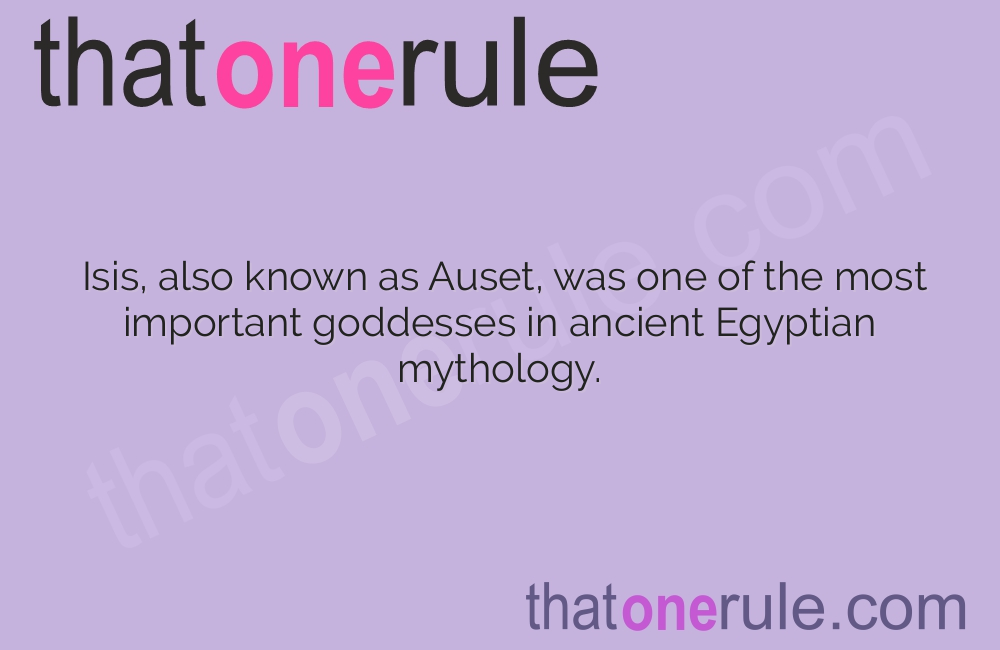Discovering the Fascinating Facts about the Isis Goddess

Isis, also known as Auset, was one of the most important goddesses in ancient Egyptian mythology.
She was the goddess of motherhood, magic, and fertility.
Isis was the wife of Osiris, the god of the afterlife, and the mother of Horus, the god of the sky.
She was often depicted with a throne-shaped headdress.
Isis was believed to have used her magical powers to heal the sick and bring the dead back to life.
She was also known as the protector of children and the downtrodden.
According to mythology, Isis managed to collect and reassemble the body parts of her husband Osiris after he was murdered by Seth.
Isis was associated with the Nile River and was revered as the bringer of life-giving waters.
Many Egyptian pharaohs claimed to have been chosen directly by Isis to rule.
Isis was considered a wise and compassionate goddess, known for her ability to listen and offer guidance.
She was often invoked by those in need of protection or assistance.
Isis was also venerated as a goddess of wisdom and knowledge.
She was believed to have taught humankind various arts and sciences, including agriculture and writing.
Isis was associated with the moon and was sometimes depicted with a lunar disk on her head.
She was also closely connected to the concept of rebirth and was worshipped as a bringer of new beginnings.
Isis was often depicted with outstretched wings, symbolizing her role as a protective deity.
Discovering the Fascinating Facts about the Isis Goddess part 2
She was considered a skilled magician and was believed to have the power to control the forces of nature.
Isis was popular not only in ancient Egypt but also in the wider Mediterranean region, where her worship spread.
Many temples were dedicated to Isis throughout Egypt, with the most famous one located on the island of Philae.
In some texts, Isis was described as the mistress of the words of power, indicating her control over magical incantations.
Isis was known to shape-shift into various forms, including that of a bird or a cow.
She was often equated with other goddesses, such as Demeter in Greek mythology and Venus in Roman mythology.
Isis was sometimes depicted as a fierce warrior goddess, armed with a bow and arrows.
She was revered not only by common people but also by powerful rulers, who saw her as a source of divine authority.
Isis was often associated with the harvest and was believed to bless the land with fertile crops.
She was said to provide comfort and solace to those who were grieving or going through difficult times.
The worship of Isis continued even after the rise of Christianity, with her cult being assimilated into certain Christian traditions.
Many ancient rituals and festivals were dedicated to Isis, celebrating her various aspects as a mother, healer, and protector.
Isis was believed to possess the secret names of the gods, which gave her immense power and influence.
She was often invoked during childbirth to ensure a safe delivery.
Isis was associated with the concept of Ma’at, the Egyptian concept of truth, justice, and cosmic order.
She was believed to have a deep connection with nature, being able to communicate with animals and plants.
Isis was venerated as a compassionate goddess who understood the hardships and struggles of mortal life.
She was often depicted holding a sistrum, a musical instrument associated with fertility and abundance.
Isis was credited with the invention of perfume and was often depicted carrying a jar of scented oil.
She was known as the Lady of Ten Thousand Names due to the multitude of her epithets and titles.
Isis was considered a keeper of sacred wisdom and was often depicted with a scroll or book in her hands.
She was believed to have control over the cycles of the moon and was invoked for lunar magic and divination.
Isis was associated with the star Sirius, which was believed to be her celestial counterpart.
She was seen as a bringer of hope and renewal, particularly during times of crisis or upheaval.
Isis was considered a protector of sailors and travelers, ensuring their safe journeys.
She was often depicted wearing a red or blue dress, symbolizing her connection to the sky and the earth.
Isis was known to have a close relationship with Hathor, the goddess of love and beauty.
She was revered as a guardian of the cosmic balance, maintaining harmony between the forces of good and evil.
Isis continues to be a source of inspiration and fascination in modern times, with her legacy enduring in art, literature, and popular culture.

